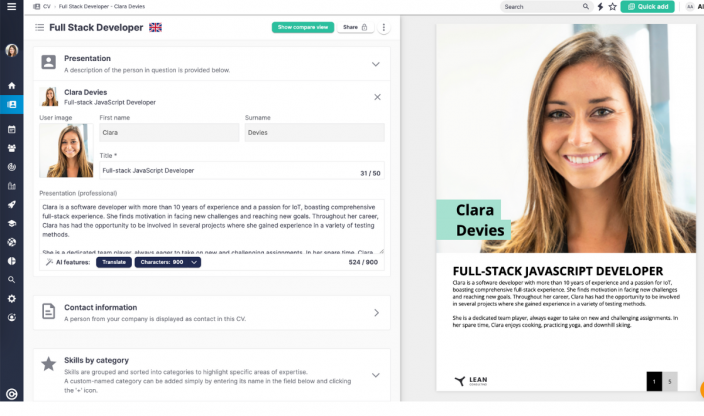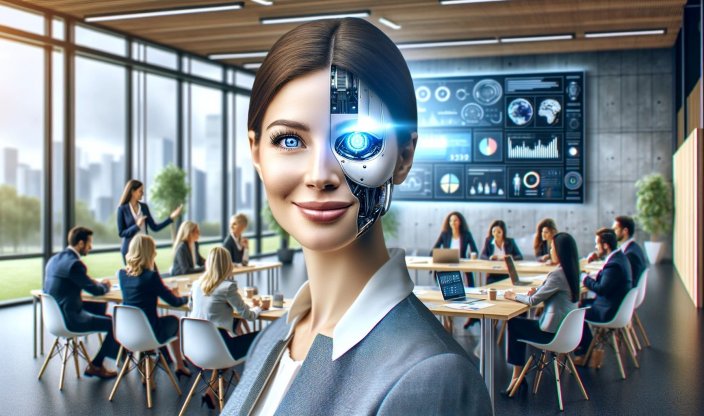Generative AI in combination with other digital platforms is the hub of the hybrid consultant

In our first post about hybrid consulting, we introduced the concept of the hybrid consultant as a fantastic combination of digital tools and humanity. In the second article, we explored its benefits for clients, consultants, and consulting firms. These posts have hopefully laid the foundation for an understanding of the versatile role of the hybrid consultant in an ever-changing and dramatically evolving world.
In our third post, out of five in this series, we turn our attention to how generative AI can be integrated into the hybrid consultant role by combining it with other digital platforms. We see combining our traditional consulting role with digital tools, data, and AI analysis as a necessity to meet the challenges of the future for both our clients and ourselves.
It’s easy to cry wolf (especially if you’re sitting in Torsby, northern Värmland, and writing this post) and exaggerate the importance of AI. But as Martin Svensson, Managing Director at AI Sweden, puts it: it’s about “either to give a walkover to others or to actually be seriously in the game”.
In a study of 700 BCG consultants, it was found that the performance of those currently using AI as a tool could increase by up to 40 percent. And we’re just at the beginning of the AI revolution. Furthermore, the groups that perform worse are the ones that benefit the most from using generative AI tools, thus democratizing the work results.
So, how do we as consultants most easily step into the game? Below are some concrete examples, based on our own proven experience.
Revolutionize your work processes with the help of AI
In the operations of DigJourney, since generative AI emerged 1.5 years ago, we have gone through three phases in our own AI transformation.
The exploratory phase involved learning how ChatGPT fundamentally operates. We tested analyzing external data, summarizing research, and integrating that type of data with our strategic documents. Here, AI helped us significantly increase the speed and quality of our core tasks. An important task was understanding our core processes and seeing how we can radically improve how we work with them using digital tools. Here’s a good list that matches various tasks and processes with tools.
The second phase focused heavily on co-creation. With tools like Miro, we revolutionized our workshops. Generative AI contributes to a more democratic collaborative process where the group’s collective intelligence is utilized in a completely different way than was previously possible.
In our third phase, we focused on finding the tool mix for the deliveries we have, with a basic set complemented by more specialized tools for specific needs. We have started building our own GPTs in OpenAI’s “app store.” We customize “apps” for specific needs in our existing processes, which in various ways support our framework for transformations. This way, we increase both our efficiency and the quality of our work.
Create more value for customers
For example, with the help of our GPT Vision Architect, we can support goal-setting processes. Or use Transformation Pathfinder to define which transformation journeys the organization needs to undertake to achieve the desired goals.
Do you have ChatGPT Plus or another premium version? Feel free to try our GPTs and let us know what you think!
We have also started integrating this with our SaaS platform for transformation, Changemkr. Currently in closed beta, we are developing it as a hub for all changemakers’ work with change and transformation. This way, we combine our external toolbox with digital services and in-house development to enable creating even more value in fewer hours, benefiting both our and others’ customers.
In our next phase, it will involve integrating generative AI and the GPTs we build for specific purposes into Changemkr, and how we can link different tools to support more automated, interconnected processes.
What digital toolbox does you and your company have that takes value creation to the next level?
“What does your digital toolbox look like?”
Everyday tasks are simplified with AI
Generative AI is currently becoming a central part of modern work practices. We can clearly see this through its integration into several existing digital tools that we are already familiar with.
Miro, the popular whiteboard service, integrates AI to perform quick AI analyses in workshops and brainstorming sessions. Salesforce Einstein provides users with deeper insights and smarter recommendations, enhancing decision-making. Features like Gmail’s Smart Compose and Microsoft’s Co-Pilot demonstrate how everyday tasks can be simplified with AI. Soon, these AI features will become as commonplace as spell checks and be part of our everyday lives.
Mastering new forms of communication is crucial
The use of AI will expand beyond the conventional text and spreadsheet applications we currently use. An exciting area is what will happen in image and video management. There is potential to revolutionize how we communicate with customers and colleagues. As change leaders and consultants, it is crucial that we master these new forms of communication effectively. Our clients expect it.
As generative AI continues to shape our world, it becomes clear that its influence extends far beyond the field of technology. We must recognize AI’s ability to profoundly impact both the functional and human aspects of our work. The future of AI is not solely about improved processes and automation. It is also about how it will reshape the very essence of the consulting role. Is there anyone who believes that we won’t dramatically need to change how we work within just a few years, or even months? It’s about understanding and adapting to how AI will redefine our relationships with customers, shape our learning processes, and create a new work culture.
The future significance of AI for consultants and the consulting industry
The journey with AI is just beginning. We are already seeing how AI impacts not only our work processes but also the human aspects of consulting. Given AI’s growing influence, it is critical that we actively explore its effects on the consulting role, client relationships, and our work culture.
In our upcoming articles, we will explore this further. Additionally, we will discuss how the consulting industry must adapt not only to survive but also to enhance its competitiveness in an increasingly AI-driven future.
What setup do you have that allows you to extract even more value as a consultant? Feel free to share your thoughts or if you have any questions about how we currently work with generative AI. You can do so here (link to Linkedin).
All consultants are now taking the first tentative steps on the AI journey; let’s learn from each other and make progress together.
We’ll talk again soon!
/Joakim Jansson and Johan Forsberg, DigJourney
PS 1: Previous posts about the Hybrid Consultant: Post 1: Soon, everyone will need to become hybrid consultants Post 2: This is how the hybrid consultant creates greater value for clients, themselves, and the consulting firm
PS 2: Are you curious to test Changemkr, our SaaS for transformation? Visit Changemkr.com and sign up to find out when we open up. Or if you can’t wait, email joakim@digjourney.com!
Free webinar: How Will AI Impact the Consulting Industry?

Guest Blogger - Joakim Jansson and Johan Forsberg from DigJourney
Guest Blogger - Joakim Jansson and Johan Forsberg from DigJourney
You may also like...
All posts
Jun 18 2024 · Consulting
Future-proof your business: steps towards an efficient, up-to-date, and sustainable consulting practice

Jun 07 2024 · Consulting
9 Ways AI is Impacting the Consulting Industry

May 28 2024 · Consulting, Konsult
Who is best at equality, really?

May 24 2024 · Consulting
Cinode Launches Europe-wide Fishing Competition for Consultants and Consultancies

May 17 2024 · Consulting
How AI and digital tools are reshaping the role of the consultant

May 11 2024 · Consulting
Get insights about your unassigned consultants

Apr 09 2024 · Cinode, Consulting
Your Consultant Resume on Autopilot with AI Support

Mar 28 2024 · Consulting
6 Easter Eggs to improve your Consultancy

Mar 26 2024 · Cinode, Consulting
8 Important Reasons to Expand Your Network of Subcontractors and Partners – And How to Do It!

Mar 19 2024 · Consulting
The hybrid consultant creates greater value for the customers, themselves, and the consulting company

Mar 12 2024 · Consulting
Soon we all have to become hybrid consultants

Feb 08 2024 · Consulting, Entrepreneurship
